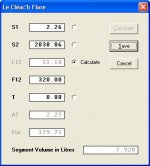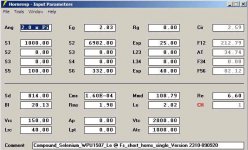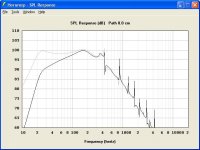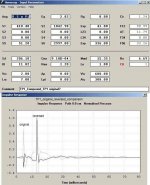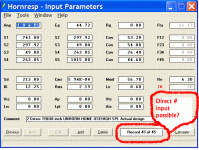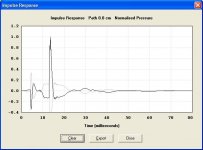Hi sumsound,
So true .
.
Calculate the results for a given value of Eg and then check the Diaphragm Displacement chart to see if the excursion has exceeded the Xmax value for the driver you have specified. After a few iterations using different values of Eg you should be able to find the maximum constant voltage that can be applied to the loudspeaker without exceeding Xmax at any frequency.
Remember though, in practice a normal audio signal voltage will not be constant at all frequencies .
.
Kind regards,
David
sumsound said:It would be pretty odd to have an amplifier that delivers constant wattage to any load.
So true
sumsound said:Is there a way to see what maximum output is for constant voltage, with respect to xmax?
Calculate the results for a given value of Eg and then check the Diaphragm Displacement chart to see if the excursion has exceeded the Xmax value for the driver you have specified. After a few iterations using different values of Eg you should be able to find the maximum constant voltage that can be applied to the loudspeaker without exceeding Xmax at any frequency.
Remember though, in practice a normal audio signal voltage will not be constant at all frequencies
Kind regards,
David
Any chance that we will be able to change Q of the port/vent in the future?
Basta! does this and you can then simulate an "aperiodic" box.
But you can't add a horn in Basta!.
You can find it here in case you haven't seen it. http://www.tolvan.com/basta/
Basta! does this and you can then simulate an "aperiodic" box.
But you can't add a horn in Basta!.
You can find it here in case you haven't seen it. http://www.tolvan.com/basta/
Any chance that we will be able to change Q of the port/vent in the future?
Hi David_Web,
It is highly unlikely.
Kind regards,
David
Compound Horn?
Hi David,
The other night I was playing around with the compound horn arrangement, trying to use it for something (think Altec 816) with: 1. short exponential front horn, 2. large vented rear chamber, 3. short exponential rear horn (used as reflex port). This seemed to model just fine (well, the response may well be too fine ). Looking a little closer I found the following:
). Looking a little closer I found the following:
- there is a point where reducing Area S2 (front horn mouth) by as little as 1cm^2 markedly affects the low end, and
- the same thing happens when reducing Area S6 (rear horn mouth) from the input screen value shown.
I'll attach the input screen for your information. It would be great if the compound horn arrangement could be used reliably for cases like this one.
Thought you might find this interesting.
Regards,
Hi David,
The other night I was playing around with the compound horn arrangement, trying to use it for something (think Altec 816) with: 1. short exponential front horn, 2. large vented rear chamber, 3. short exponential rear horn (used as reflex port). This seemed to model just fine (well, the response may well be too fine
- there is a point where reducing Area S2 (front horn mouth) by as little as 1cm^2 markedly affects the low end, and
- the same thing happens when reducing Area S6 (rear horn mouth) from the input screen value shown.
I'll attach the input screen for your information. It would be great if the compound horn arrangement could be used reliably for cases like this one.
Thought you might find this interesting.
Regards,
Attachments
Thought you might find this interesting.
Hi Oliver,
Many thanks - I certainly do find it interesting!
When I first calculate the combined response for your example, I get a particular result. If I then calculate the combined response again (without changing anything) I get a different result - see attached comparison. There is definitely a bug somewhere
I will investigate over the next few days, and let you know what I find.
Kind regards,
David
Attachments
I will investigate over the next few days, and let you know what I find.
Hi Oliver,
Just letting you know that the bug you reported has been fixed - it only took one keystroke to rectify
Thanks again for bring this bug to my attention - it was causing quite a serious error in the results!
The corrected Hornresp release is Product Number 2310-090924.
Kind regards,
David
Post #728, Compound Horn
Hi David,
Thanks for getting to this problem as quickly as you did. I'm happy you were able to find an easy to fix cause.
I did not believe the impressive low frequency output , that's what got me to look at it a little closer. The data I'm getting now looks a lot more real, still quite nice though. I'm also having a bit of a problem with a simulation of the Lowther TP1 London, but I'm still extracting data from the drawing. I'll post it as soon as I have something.
, that's what got me to look at it a little closer. The data I'm getting now looks a lot more real, still quite nice though. I'm also having a bit of a problem with a simulation of the Lowther TP1 London, but I'm still extracting data from the drawing. I'll post it as soon as I have something.
Thanks again for the quick response,
Regards,
Hi David,
Thanks for getting to this problem as quickly as you did. I'm happy you were able to find an easy to fix cause.
I did not believe the impressive low frequency output
Thanks again for the quick response,
Regards,
Hi David,
Is it possible that, after you've typed the length in L12 (etc.) the horn flare automatically adjusts to, say conical, instead of requiring the push of that extra button, (like C, H or E) that I regulairy forget?
I know, I know but it just keeps on happening (and resetting)
Best regards Johan
Is it possible that, after you've typed the length in L12 (etc.) the horn flare automatically adjusts to, say conical, instead of requiring the push of that extra button, (like C, H or E) that I regulairy forget?
I know, I know but it just keeps on happening (and resetting)
Best regards Johan
Compound Horn_Post #729
Hi David,
As I said in Post #729 I also had a bit of a problem with a simulation of the Lowther TP1 London. When swapping the horns there was a large difference in the SPL response curves. Your fix - Post #728 - rectified that. There still is a difference, and I would expect some difference. But my guess is that the impulse responses should resemble each other more closely. Also, to compare the impulse responses from different simulations more easily it would help to have control over the Y-axis settings. As you can see, the large negative peak of the original impulse response is way of the page.
Looks like there may be something else here that needs your attention.
Regards and Thanks,

Hi David,
As I said in Post #729 I also had a bit of a problem with a simulation of the Lowther TP1 London. When swapping the horns there was a large difference in the SPL response curves. Your fix - Post #728 - rectified that. There still is a difference, and I would expect some difference. But my guess is that the impulse responses should resemble each other more closely. Also, to compare the impulse responses from different simulations more easily it would help to have control over the Y-axis settings. As you can see, the large negative peak of the original impulse response is way of the page.
Looks like there may be something else here that needs your attention.
Regards and Thanks,
Attachments
Hello David
Is there any way it would be possible to make it a little easier to go to a saved design by typing the design number in. I'm working on more and more designs and clicking through them all is getting a bit tough. I know that other gentlemen have a great many more designs saved than I do.
Mark
Is there any way it would be possible to make it a little easier to go to a saved design by typing the design number in. I'm working on more and more designs and clicking through them all is getting a bit tough. I know that other gentlemen have a great many more designs saved than I do.
Mark
Attachments
Is it possible that, after you've typed the length in L12 (etc.) the horn flare automatically adjusts to, say conical, instead of requiring the push of that extra button, (like C, H or E) that I regularly forget?
Hi Johan,
While it is certainly possible, all things considered I would prefer to leave things as they are, with the selection of the initial flare being the responsibility of the user. Sorry, but you are just going to have to learn not to forget
Kind regards,
David
Hi Oliver,
When you say "swapping the horns", I assume you mean interchanging the front chamber and front horn with the rear chamber and rear horn. The combined response results for these two "mirror image" configurations should be identical. It took me a while to find the problem, but it turned out to be just another case of S2 being used instead of S22. The bug was not there originally, but was inadvertently introduced when I made a refinement to the compound horn model .
.
I think everything is working correctly now.
The combined response impulse response results for the two configurations should be mirror images of each other, as shown in the attachment below. Gray is original, black is reversed. Viewing the two impulse response charts separately will show this a bit more clearly.
Note that to make the two test configurations exactly the same, I used Lrc = 8 rather than Lrc = 7 in the original configuration so that Vtc = 2000 and Atc = 250 in the reversed configuration. Using Lrc = 7 would have meant that Atc would need to have been rounded to two decimal places (285.71) in the reversed configuration.
As indicated on page 12 of the Hornresp Help file, the peak pressure amplitude of the impulse response is normalised to 1. Because of this there is probably not much to be gained by having an adjustable range on the Y-axis. Actual peak amplitudes are not available for comparison in any event. As mentioned above, the two impulse response charts can always be viewed individually. I often take multiple screenprints and paste them into a temporary Word document for easy comparison.
Many thanks for unearthing this second bug. Hopefully there are not too many more left to be discovered .
.
The latest Hornresp release is Product Number 2310-090925.
Kind regards,
David
When swapping the horns there was a large difference in the SPL response curves. Your fix - Post #728 - rectified that. There still is a difference, and I would expect some difference.
When you say "swapping the horns", I assume you mean interchanging the front chamber and front horn with the rear chamber and rear horn. The combined response results for these two "mirror image" configurations should be identical. It took me a while to find the problem, but it turned out to be just another case of S2 being used instead of S22. The bug was not there originally, but was inadvertently introduced when I made a refinement to the compound horn model
I think everything is working correctly now.
But my guess is that the impulse responses should resemble each other more closely.
The combined response impulse response results for the two configurations should be mirror images of each other, as shown in the attachment below. Gray is original, black is reversed. Viewing the two impulse response charts separately will show this a bit more clearly.
Note that to make the two test configurations exactly the same, I used Lrc = 8 rather than Lrc = 7 in the original configuration so that Vtc = 2000 and Atc = 250 in the reversed configuration. Using Lrc = 7 would have meant that Atc would need to have been rounded to two decimal places (285.71) in the reversed configuration.
Also, to compare the impulse responses from different simulations more easily it would help to have control over the Y-axis settings. As you can see, the large negative peak of the original impulse response is way off the page.
As indicated on page 12 of the Hornresp Help file, the peak pressure amplitude of the impulse response is normalised to 1. Because of this there is probably not much to be gained by having an adjustable range on the Y-axis. Actual peak amplitudes are not available for comparison in any event. As mentioned above, the two impulse response charts can always be viewed individually. I often take multiple screenprints and paste them into a temporary Word document for easy comparison.
Many thanks for unearthing this second bug. Hopefully there are not too many more left to be discovered
The latest Hornresp release is Product Number 2310-090925.
Kind regards,
David
Attachments
Last edited:
Is there any way it would be possible to make it a little easier to go to a saved design by typing the design number in. I'm working on more and more designs and clicking through them all is getting a bit tough.
Hi Mark,
In case you are not aware of it, holding down the Page Up, Page Down or Enter key on the keyboard allows you to navigate more quickly through the records. Note that it is not necessary to keep clicking on the Hornresp Next or Previous button. Also, the Home key can be used to move directly to the first record, and the End key can be used to move directly to the last record.
Alternatively you can select File > Find from the Input Parameters window. Enter either the record number if you know it, for example 0077, or some part of the comment field you are looking for. You can also use the filter provided, to further narrow the search parameters. Then simply double-click on the record you want, to display it.
Hope this helps.
Kind regards,
David
Last edited:
Post #734 Compound Horn
Hi David,
Thanks for fixing another bug. I downloaded and installed V2310-090925 and everything looks fine.
I downloaded and installed V2310-090925 and everything looks fine.
With swapping the horns I literally ment attaching the long rear horn to the small front chamber, and attaching the short front horn to the rear chamber. I actually got less of a difference between these two configurations than I expected. (Come to think of it, there actually is no throat chamber in that design. Well, just pondering anyhow.)
Thanks for the clarification on the impulse response data.
Regards,
Hi David,
Thanks for fixing another bug.
With swapping the horns I literally ment attaching the long rear horn to the small front chamber, and attaching the short front horn to the rear chamber. I actually got less of a difference between these two configurations than I expected. (Come to think of it, there actually is no throat chamber in that design. Well, just pondering anyhow.)
Thanks for the clarification on the impulse response data.
Regards,
I have a little problem.
Generated impulse disagrees with hornresps SPL.
This happens for most reverse tapered TH (T-TQWT or what it's called) But to lesser degree for other as well.
Here is a picture of what I mean. The scale should be close enough.
I used HOLMImpulse to load the IR.
There are other differences as well when using normal TH.
More output below tuning, different behavior above passband.
The added bass below tuning does add up to observations that TH gives more output than predicted. But which is really accurate?
Difference is there regardless of pi. Although they seem to change a little differently.
Thanks again for adding the IR export. It has really helped to develop and analyze better and better designs.
Generated impulse disagrees with hornresps SPL.
This happens for most reverse tapered TH (T-TQWT or what it's called) But to lesser degree for other as well.
Here is a picture of what I mean. The scale should be close enough.
I used HOLMImpulse to load the IR.
An externally hosted image should be here but it was not working when we last tested it.
There are other differences as well when using normal TH.
More output below tuning, different behavior above passband.
An externally hosted image should be here but it was not working when we last tested it.
The added bass below tuning does add up to observations that TH gives more output than predicted. But which is really accurate?
Difference is there regardless of pi. Although they seem to change a little differently.
Thanks again for adding the IR export. It has really helped to develop and analyze better and better designs.
An externally hosted image should be here but it was not working when we last tested it.
The added bass below tuning does add up to observations that TH gives more output than predicted. But which is really accurate?
Difference is there regardless of pi. Although they seem to change a little differently.
Thanks again for adding the IR export. It has really helped to develop and analyze better and better designs.
I just tried this with a TH I'm fiddling with and got a similar result. Using Holmimpulse v. 1.2.1.2 (the latest crashes on me) and the latest Hornresp.
- Home
- Loudspeakers
- Subwoofers
- Hornresp
